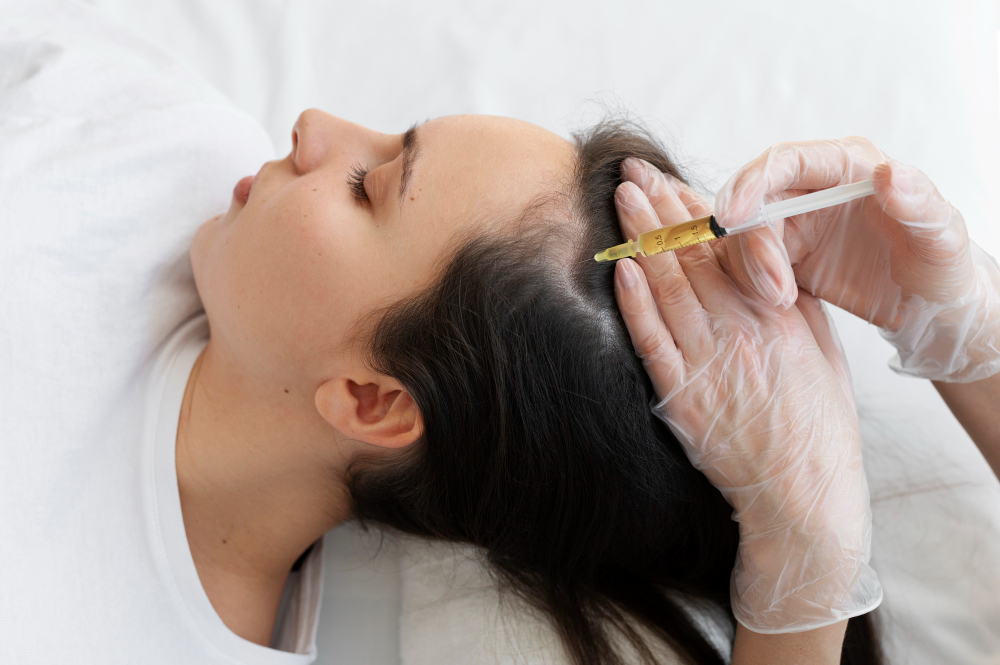PRP for Hair Restoration vs. Other Hair Restoration Treatments
 Losing hair as you age is a common problem for both men and women. A very social and visible lifestyle can sometimes cause a loss of self-esteem in people who suffer from thinning hair. This has led to a growing demand for effective hair restoration treatments.
Losing hair as you age is a common problem for both men and women. A very social and visible lifestyle can sometimes cause a loss of self-esteem in people who suffer from thinning hair. This has led to a growing demand for effective hair restoration treatments.
Platelet-rich plasma (PRP) therapy has gained popularity as a non-surgical option for hair restoration. Here, we take a look at the differences between PRP and other hair restoration methods to help you make an informed decision.
Medications for Hair Restoration
There are medications available for hair loss. They are cost-effective and widely available, with proven results. However, they provide only temporary results requiring continuous use and have potential side-effects like scalp irritation or decreased libido.
Compared to PRP, medications are more affordable but may not offer the same long-term regenerative effects.
Hair Transplant Surgery
Hair transplant surgery moves hair follicles from a donor site to thinning or balding areas using follicular unit transplantation (FUT) or follicular unit extraction (FUE). It offers permanent, natural-looking results for advanced hair loss. But it comes at a high cost, with surgical risks (scarring and infection), and extended recovery time.
While hair transplants offer permanent solutions, PRP therapy is non-surgical and involves little to no downtime. PRP can also complement transplant surgery by promoting healing and improving the survival rate of transplanted follicles.
Also Read: Can Platelet-Rich Plasma (PRP) Therapy Help in Hair Restoration?
Laser Therapy
Low-level laser therapy (LLLT) uses light energy to stimulate hair follicles, boost scalp blood flow, and encourage growth. Though they are non-invasive, painless, and suitable for men and women, they require months of consistent use in addition to being expensive, and their effectiveness too varies across individuals.
Compared to PRP, laser therapy is less invasive but often less effective for individuals with significant hair loss. PRP’s targeted approach allows for more noticeable improvements in hair density and quality.
Advantages of PRP for Hair Restoration
Each hair restoration treatment has its advantages and limitations. PRP therapy stands out for its ability to rejuvenate hair follicles using the body’s natural growth factors, making it a safe and effective option for many. Unlike other treatments, PRP can complement surgeries or medications for enhanced results. It provides longer-lasting benefits with fewer risks than medications or laser therapy.
Frequently Asked Questions
1. What is PRP for hair restoration?
PRP (Platelet-Rich Plasma) therapy is a non-surgical treatment that uses your body’s growth factors to rejuvenate hair follicles and promote hair regrowth.
2. How does PRP compare to medications for hair restoration?
PRP offers long-term regenerative effects with fewer side effects, while medications are affordable but provide temporary results with potential side effects like scalp irritation.
3. What are the risks of hair transplant surgery?
Hair transplant surgery is costly, carries risks like scarring and infection, and requires a longer recovery time. However, it provides permanent results for advanced hair loss.
4. Is laser therapy effective for hair restoration?
Laser therapy is a non-invasive treatment that stimulates hair growth, but it requires consistent use and can be less effective for individuals with significant hair loss compared to PRP.
5. What are the advantages of PRP for hair restoration?
PRP is a non-surgical, natural option with fewer risks. It provides longer-lasting results, complements other treatments like transplants, and rejuvenates hair follicles for improved hair density.
- Feb 04, 2025
